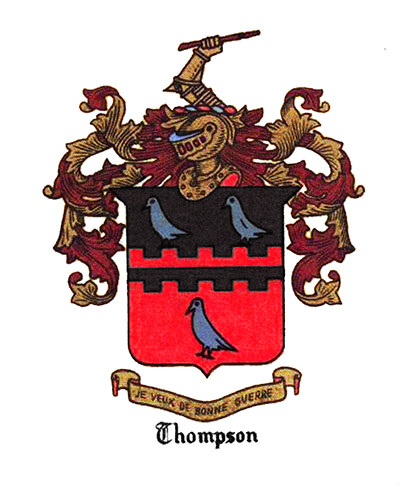
My (Dan's) mother's maiden name is Thompson, so I have as much genealogical claim to the Thompson coat of arms as I do to the Bullock coat of arms.
The image above was provided by my mother, and it has been handed down through her family. We don't have a comprehensive genealogy for her side of the family, but I did some research based on the coat of arms she provided, which indicates an English origin (just as with the Bullock coat of arms).
There are two entries in Sir Bernard Burke's "The general armory of England, Scotland, Ireland, and Wales: comprising a registry of armorial bearings from the earliest to the present time" (1864), that seem to most closely match the coat of arms as displayed. The two Thompsons that used the same motto were "Newcastle-on-Tyne, co. Northumberland, Benjamin Thompson, Esq., of that place," and "Meysey-Thompson, Kirby Hall, co. York, bart.," both of which use the same armorial description. (This description also closely matches one provided by my mother, passed down through the family.)
It reads:
"Arms - Per fess ar and sa. a fess embattled counter-embattled between three falcons counterchanged, belled and jessed or.
"Crest - An arm embowed in armour quarterly or and az. holding in the gauntlet proper the truncheon of a broken lance gold.
"Motto - 'Je veux de bonne guerre.' "
Now, admittedly, the traditional language of heraldry is like trying to read Sanskrit. (Note: if you can read Sanskrit, understand it's just a figure of speech! We love you, too...) So, let's see what all this actually means.
The "arms" is the shield portion. A "fess" is a horizontal line dividing a coat of arms, symbolizing readiness to serve. "Per fess" means the shield is halved horizontally. "Ar" is the abbreviation for argent, meaning silver or white, and "sa" is the abbreviation for sable, or black.
When a line ("fess") is "embattled," it's crenellated, looking like a square wave, representing the battlements of a castle. When a fess is embattled, only the topmost edge is altered; when both edges are to be embattled, the term "embattled counter-embattled" is used. Embattled lines symbolize defense.
The three falcons are "counterchanged," which means their colors are divided the same way as the field they are placed upon, with the colors reversed. "Belled" means they are wearing bells, and "jessed" refers to the straps on their legs that falconers would use to restrain them. "Or" means gold (from the French word). Falcons symbolize those who do not rest until they achieve their objective.
The crest is the portion above the shield. "Embowed" means bent. "Or," again, is gold, and "az" is the abbreviation for azure, or blue. "Proper" means represented in its natural color. The arm in armor symbolizes leadership, the gauntlet symbolizes being armed for military service, and the broken lance seems to symbolize success in jousting, thus more broadly, victory in pursuits.
The motto translates as "I wish for a fair fight." Overall, there seems to be a theme of military service, which is appropriate for Dan, as a career professional military man.
My mother's version of the coat of arms matches the 1864 Burke description very closely, but not exactly. For one thing, the colors are to be silver and black, top to bottom, rather than black and red, and the falcons are to be the opposite, rather than blue. Argent (silver) symbolizes peace, and sable (black) symbolizes constancy.
So, with apologies to whoever came up with the original version depicted above, I humbly submit my revision of the coat of arms to match the ancient heraldic description:

Thanks for reading!